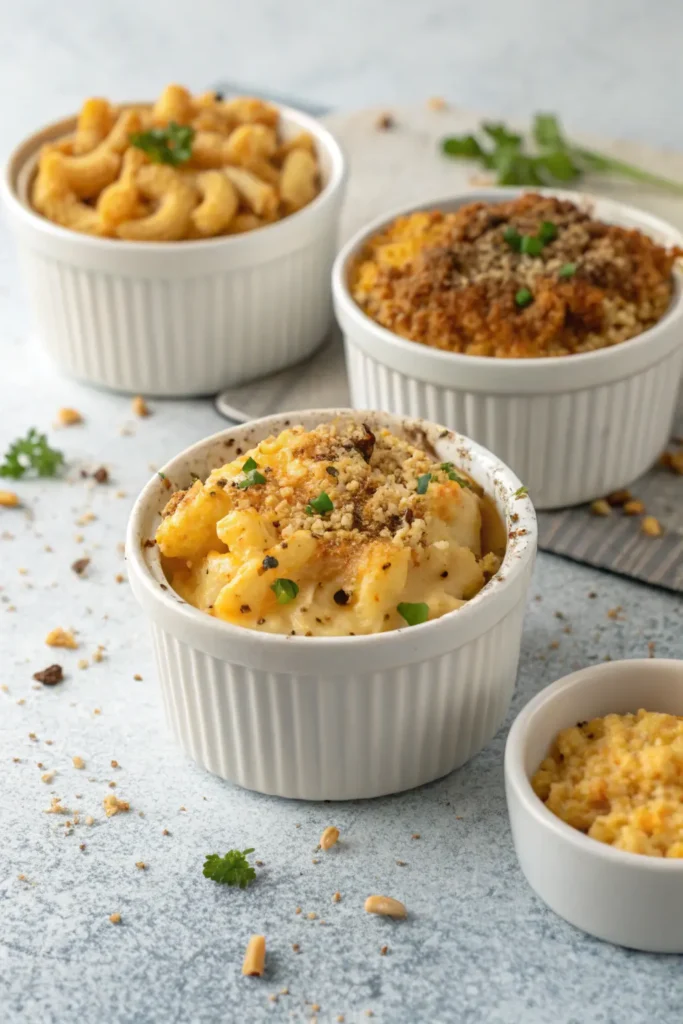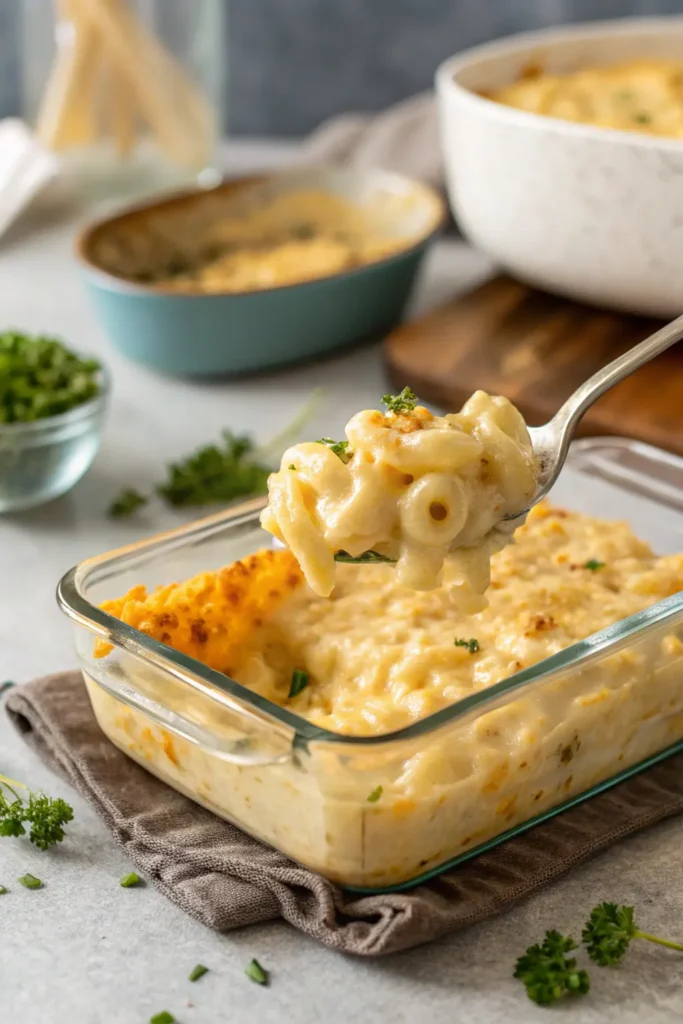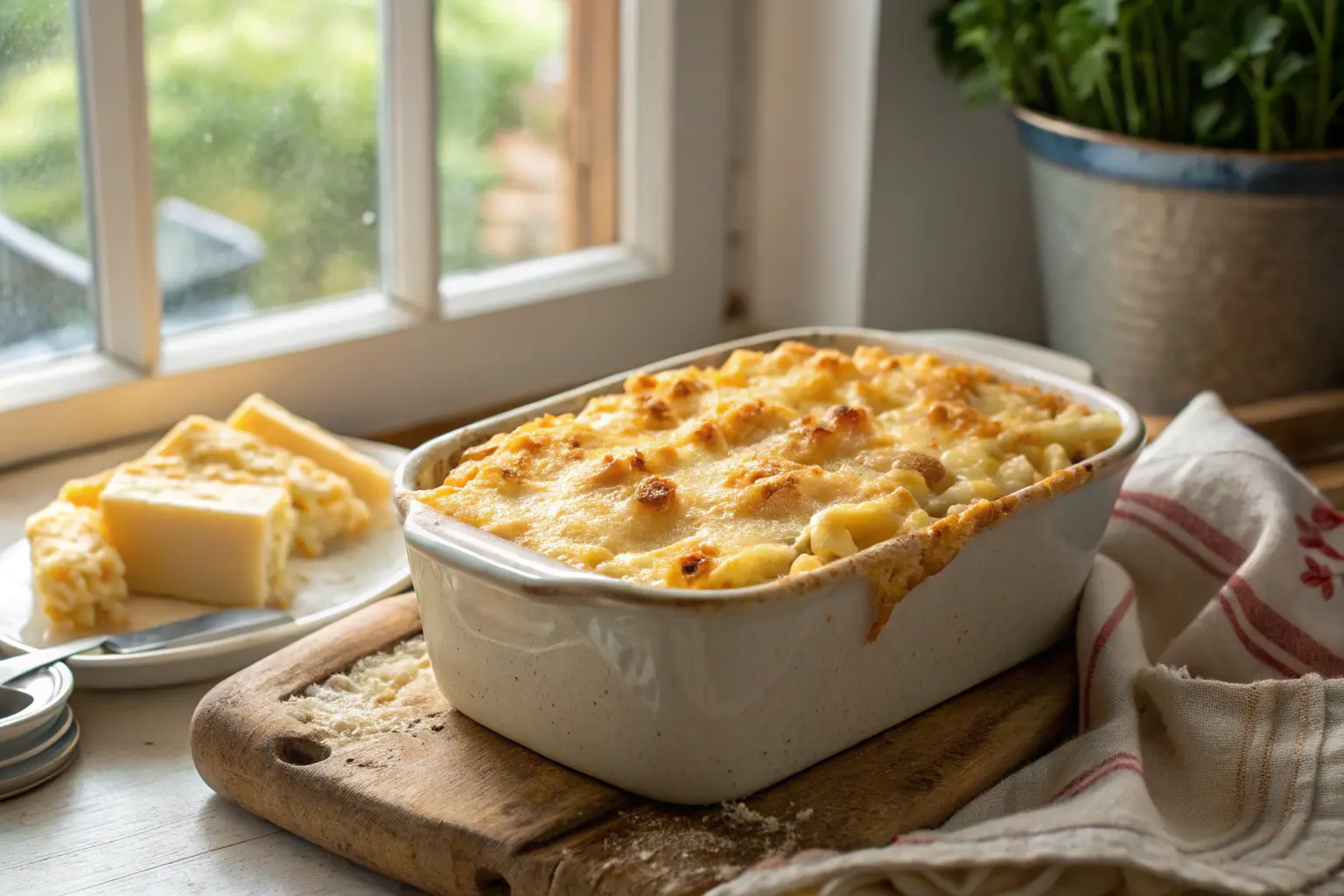There’s a reason creamy baked mac and cheese sits at the top of the comfort food pyramid. It’s rich, satisfying, and nostalgic all at once. That golden, bubbling cheese crust? Irresistible. The velvety, creamy sauce clinging to every bite of pasta? Pure magic. But here’s the thing—getting it just right isn’t always easy.
In this ultimate guide, we’re diving deep into everything you need to know about creamy baked mac and cheese. From choosing the right cheeses and pasta to mastering the perfect cheese sauce, this article walks you step-by-step through the process. We’ll cover flavor-enhancing tricks, popular variations (like Southern-style or vegan options), and common mistakes to avoid. You’ll also find practical storage tips and pro reheating methods that keep the creaminess intact—no more dry leftovers.
By the time you finish reading, you’ll have everything you need to create a dish so good, your guests will swear it came from a five-star kitchen.
Discover with us this easy and delicious recipe: Burger King Chicken Burger Sauce
Introduction to Creamy Baked Mac and Cheese
What Makes Mac and Cheese “Creamy”?
Let’s be honest—baked mac and cheese is only as good as its sauce. If it’s not smooth, rich, and creamy, you’re missing the magic. So, what’s the secret behind that dreamy texture?
It all starts with balance. The right blend of cheese, dairy, and fat creates the velvety sauce that defines great creamy baked mac and cheese. Most recipes begin with a classic béchamel sauce—a simple mix of butter, flour, and milk. This base acts like a blank canvas, ready to soak up all the cheesy goodness you toss into it.
Now, not just any cheese will do. Sharp cheddar brings bold flavor, but it doesn’t always melt like a dream. That’s where melty cheeses like mozzarella, Gruyère, or even Monterey Jack step in. Want to dial it up even further? Stir in a spoonful of cream cheese or sour cream for an ultra-luxe texture that stays silky even after baking.
And here’s something many folks overlook: the quality of cheese. Skip the pre-shredded kind loaded with anti-caking agents. Always grate it fresh for the smoothest, creamiest results.
Why Baking Makes It Better
So why not stop at stovetop mac and cheese? Because baking turns this humble dish into something truly crave-worthy. It adds texture, structure, and flavor depth that stovetop versions just can’t match.
When you pop that casserole dish into the oven, magic happens. The top layer forms a crispy, golden crust—especially if you top it with buttery breadcrumbs or extra cheese. That contrast between crunchy top and creamy center? It’s what makes baked mac and cheese a standout dish at any table.
But it’s not just about texture. Baking also helps all those flavors settle and concentrate. As it cooks, the sauce thickens slightly, binding the pasta and cheese into one perfectly scoopable, mouthwatering masterpiece.
Think of it as the difference between a quick snack and a slow-cooked comfort feast. Creamy baked mac and cheese isn’t just food—it’s an experience.
Discover with us this easy and delicious recipe: recipesfreesh
Ingredients That Make the Best Creamy Baked Mac and Cheese

Must-Have Cheeses for Maximum Creaminess
When building a truly creamy baked mac and cheese, the type of cheese you use is a game-changer. Not all cheeses melt the same, and choosing the right blend makes all the difference between a smooth, velvety sauce and a gritty, oily mess.
Start with sharp cheddar cheese. It’s a classic for a reason—offering bold flavor and decent melting ability. But cheddar alone isn’t enough. That’s why many top recipes mix in Gruyère, which melts beautifully and adds a slightly nutty depth. Want a more gooey pull? Mozzarella or Monterey Jack can help with that stringy, stretchy factor we all love.
For extra creaminess, consider adding a bit of cream cheese, mascarpone, or Velveeta (yes, even the processed kind has its place). These cheeses boost smoothness and help bind everything together without overpowering the flavor.
Whatever you do, avoid pre-shredded cheeses. They often contain anti-caking agents that stop them from melting smoothly. Grating cheese fresh off the block may take a few extra minutes, but the difference is night and day.
Choosing the Right Pasta Shape
While cheese might steal the show, don’t sleep on the pasta. The best macaroni and cheese holds onto that luscious sauce like a sponge—and that’s all about shape and surface area.
Elbow macaroni is the traditional pick, and for good reason. Its hollow center and curved edges are perfect for trapping creamy sauce. But if you’re feeling adventurous, try cavatappi, shells, or rotini. These shapes have ridges and grooves that hug every bit of that cheesy goodness.
Just as important as shape? Cook time. Always cook your pasta al dente—slightly firm to the bite. Since you’ll be baking it afterward, overcooked noodles can turn mushy fast. Drain early, and let the oven finish the job.
Additional Flavor Enhancers
Sure, cheese and pasta make a great pair, but a few small tweaks can elevate your creamy baked mac and cheese from good to unforgettable.
Start with a pinch of ground mustard or Dijon. It cuts through the richness and brings out the sharpness in your cheese. A dash of paprika adds warmth and color, while a little garlic powder or onion powder builds depth.
Some home chefs also stir in hot sauce, nutmeg, or even Worcestershire sauce for an unexpected flavor boost. These are subtle additions, but they round out the dish and keep your taste buds coming back for more.
Want to take things up a notch? Stir in some crispy bacon bits, caramelized onions, or roasted jalapeños right into the mix. The possibilities are endless.
Step-by-Step Recipe for Perfect Creamy Baked Mac and Cheese
Preparing the Roux and Cheese Sauce
Every unforgettable creamy baked mac and cheese starts with a smooth, rich cheese sauce—and that begins with a simple roux.
In a saucepan over medium heat, melt unsalted butter, then whisk in all-purpose flour. Stir constantly for about 1–2 minutes until the mixture bubbles but doesn’t brown. This step helps eliminate the raw flour taste.
Next, slowly pour in warm milk—preferably whole milk or even half-and-half—for that rich, full-bodied flavor. Keep whisking to prevent lumps from forming. Once the mixture thickens slightly, you’re ready for the magic: stir in your shredded cheeses a handful at a time.
Pro tip: Turn the heat to low before adding the cheese. High heat can cause the proteins to break, leading to a gritty sauce. Stir until the cheese is completely melted and the sauce is smooth.
Cooking the Pasta Just Right
While your sauce comes together, cook the pasta. And here’s the trick—don’t fully cook it. Instead, boil your pasta 1 to 2 minutes less than the package suggests.
Why? Because it’ll continue cooking in the oven. This ensures your noodles don’t go soft or soggy and helps the dish hold its shape once baked.
After draining, avoid rinsing the pasta. You want the starch to stay on the surface—it helps the sauce stick better. Immediately toss the pasta into your finished cheese sauce so it absorbs flavor while still warm.
Assembling and Baking the Dish
Now comes the best part—bringing everything together. Start by lightly greasing your baking dish. Pour in the mac and cheese mixture and smooth the top with a spatula.
Want a golden crust? Sprinkle a generous layer of shredded cheddar, panko breadcrumbs, or crushed Ritz crackers on top. For even more indulgence, drizzle melted butter over the breadcrumbs before baking.
Bake in a preheated oven at 350°F (175°C) for 20–25 minutes, or until bubbly and lightly browned on top. Don’t overbake—it can dry out the sauce. Let it rest for 5–10 minutes before serving so the cheese sets slightly.
And there you have it—a piping-hot, golden, creamy baked mac and cheese straight from your oven to the table.
Variations of Creamy Baked Mac and Cheese

Classic Southern Baked Mac and Cheese
If you’ve ever had mac and cheese at a Southern cookout, you know it hits differently. Southern-style creamy baked mac and cheese is thicker, richer, and often made with eggs to create a custard-like base that holds together in firm, cheesy squares.
The traditional Southern version often skips the roux and instead uses a mix of evaporated milk, eggs, butter, and loads of sharp cheddar. It’s baked longer than other versions, giving it a dense yet creamy center with that golden, crusty top everyone loves.
For a deeper flavor, many Southern cooks add a layer of sliced cheese between the pasta layers or use a mix of extra sharp cheddar and Colby Jack. It’s indulgent, filling, and guaranteed to be the first dish gone at any potluck.
Creamy Mac and Cheese with a Crunchy Topping
There’s something about that first bite of crunchy topping followed by a soft, cheesy interior that makes oven-baked mac and cheese so satisfying. While some folks keep it simple with just cheese on top, others love to add texture—and we highly recommend you try it.
To create the perfect crunchy finish, sprinkle a mix of panko breadcrumbs and grated Parmesan cheese over your mac and cheese before baking. For even more flavor, toss the crumbs with melted butter, garlic powder, or smoked paprika.
If you’re feeling extra fancy, crushed crackers like Ritz or even fried onions can add a savory twist. These toppings toast up beautifully in the oven and give every bite a satisfying crunch to balance the creamy base.
Vegan and Dairy-Free Alternatives
Can you make creamy baked mac and cheese without dairy? Absolutely. With the rise of plant-based eating, there are more ways than ever to enjoy this classic dish without animal products—and still get that rich, creamy texture.
Start by swapping regular milk with unsweetened almond, oat, or soy milk. For that cheesy taste, use a mix of nutritional yeast, dairy-free cheddar-style shreds, and a base of cashew cream or even blended cauliflower for added nutrients.
You can also create a thick vegan roux using plant-based butter and flour, then stir in your cheese substitutes. Don’t forget to season well—mustard, garlic powder, and smoked paprika all help mimic the umami flavor of traditional cheese.
While it may not taste exactly like the original, a vegan version can still deliver that creamy, cozy satisfaction—without the dairy.
Expert Tips and Common Mistakes to Avoid
How to Prevent Grainy or Oily Cheese Sauce
There’s nothing worse than pouring time and effort into a dish, only to end up with a gritty or oily mess instead of a smooth cheese sauce. Luckily, a few smart steps can save your creamy baked mac and cheese from disaster.
First, don’t rush the sauce. High heat can cause the proteins in the cheese to separate, leaving you with an oily texture. Keep the heat low when adding cheese, and stir gently until fully melted.
Second, use a béchamel base—that’s the flour and butter roux we talked about earlier. It helps emulsify the fat in the cheese with the milk, resulting in a cohesive, smooth sauce.
Lastly, avoid pre-shredded cheese. Those anti-caking agents stop cheese from melting properly, leading to clumps or separation. Always grate your cheese fresh for the silkiest texture.
Tips to Keep Baked Mac and Cheese Moist
No one likes dry mac and cheese. But once you bake it, moisture can evaporate quickly, especially from the edges. So how do you keep your dish moist and creamy?
One way is to slightly undercook your pasta. This allows it to absorb the sauce without over-softening or drying out in the oven. You should also make sure your sauce is on the thicker side—thin sauces dry up faster.
Cover your mac and cheese with foil for the first part of baking. This traps moisture inside. Remove the foil in the last 10 minutes to let the top get golden and crisp.
Another trick? Mix in a splash of heavy cream or a dollop of cream cheese before baking. These ingredients help retain moisture and improve texture, so your mac stays creamy even after reheating.
Pairing Ideas and Serving Suggestions
Best Proteins and Sides to Serve With
Creamy Baked Mac and Cheese is rich, indulgent, and satisfying all on its own—but it truly shines when paired with the right sides or proteins. If you want to turn this dish into a full meal or build the perfect dinner spread, a few classic pairings can make all the difference.
For proteins, you can’t go wrong with something savory and juicy. Think BBQ ribs, fried chicken, or even grilled sausage. The smoky flavor of barbecue or the crispiness of fried chicken cuts through the creaminess, offering a delicious contrast in both texture and taste.
If you’re aiming for a lighter pairing, go with baked salmon or roasted turkey breast. These leaner proteins add balance to the richness of your cheesy pasta.
When it comes to sides, simple is best. Green beans, collard greens, or a fresh garden salad all work well. Their crispness and bright flavors offset the heaviness of the mac and cheese, making each bite feel fresh. Roasted vegetables like carrots, broccoli, or Brussels sprouts also pair wonderfully and add a colorful touch to your plate.
Don’t forget: a side of cornbread or garlic toast can also turn this into the ultimate comfort meal.
Presentation Tips for a Family or Party Meal
Serving creamy baked mac and cheese at a dinner party or holiday gathering? Presentation matters just as much as flavor. Thankfully, it’s easy to make this dish look as good as it tastes.
Start by baking your mac and cheese in a cast iron skillet or a rustic ceramic casserole dish. Not only does this help with even heat distribution, but it also adds a charming, homey look right from oven to table.
For individual portions, use ramekins or mini cocottes. These make it easier to serve and look upscale for events. Garnish each serving with a sprinkle of fresh herbs like parsley or chives for a pop of color.
If you’re feeding a crowd, keep the baked dish on a warming tray and provide serving utensils that don’t scrape the crust off the top. Trust us, everyone wants that crispy, cheesy topping intact.
Storing, Reheating, and Freezing Creamy Baked Mac and Cheese

Best Practices for Storage
Leftovers of creamy baked mac and cheese can be just as delicious—if stored the right way. The key is to lock in that moisture and flavor so your next-day mac is just as creamy and satisfying.
First, allow the dish to cool completely before storing. Then transfer it into an airtight container. For best results, divide it into single-serving portions. This not only saves space in the fridge but also makes reheating much easier.
Stored properly, it will last for up to 4 days in the refrigerator. Don’t forget to label your containers with the date so you can keep track.
If you plan to eat it within a day or two, you can also just wrap the baking dish tightly with aluminum foil or plastic wrap and store it directly.
Reheating Without Drying It Out
Reheating baked mac and cheese can be tricky. Without the right technique, it often ends up dry or rubbery. But don’t worry—there’s a way to bring back that creamy texture.
For the best results, reheat in the oven. Preheat to 350°F, place the mac and cheese in an oven-safe dish, and add a splash of milk or cream to restore moisture. Cover with foil and bake for about 15–20 minutes. Remove the foil during the last 5 minutes to re-crisp the top.
If you’re short on time, you can use the microwave. Add a splash of liquid, cover the bowl with a microwave-safe lid, and heat in 30-second intervals, stirring in between. Just be careful not to overheat—it’s easy to go from creamy to dried out in seconds.
Can You Freeze Creamy Baked Mac and Cheese?
Absolutely—you can freeze creamy baked mac and cheese, and it holds up surprisingly well. In fact, freezing is a great option if you’re prepping ahead for holidays or meal planning.
To freeze, let the mac and cheese cool completely. Then spoon it into freezer-safe containers or zip-top bags. Be sure to remove as much air as possible to prevent freezer burn. Label and date your container, and it’ll stay fresh for up to 3 months.
When you’re ready to enjoy it, thaw in the fridge overnight. Then reheat using the oven or microwave method described above. Don’t forget to add a bit of milk or cream before reheating to bring back the creaminess.
Nutritional Breakdown and Ingredient Substitutes
Calories and Macronutrient Overview
While creamy baked mac and cheese is beloved for its rich taste and comforting texture, it’s also known for being on the indulgent side. But understanding the nutritional makeup of your serving can help you enjoy it mindfully—and even tweak it to fit your goals.
On average, one serving (about 1 cup) contains approximately:
- Calories: 350–450
- Protein: 12–18g
- Fat: 20–30g
- Carbohydrates: 25–35g
Of course, the numbers can swing higher or lower depending on your ingredients. Whole milk, full-fat cheese, butter, and pasta all add up quickly. But thankfully, there are plenty of ingredient swaps you can make to cut back on calories or adapt it to your dietary needs—without sacrificing that creamy goodness.
Substituting for Dietary Needs
Whether you’re cutting calories, avoiding dairy, or just want a healthier spin on your favorite dish, there are several smart swaps to make your creamy baked mac and cheese fit your needs.
- For a lighter version: Use low-fat milk or evaporated skim milk, and reduce the butter by half. Replace full-fat cheese with reduced-fat options, but keep in mind that some low-fat cheeses don’t melt as well.
- Gluten-free option: Use gluten-free pasta made from rice, corn, or quinoa. Be sure to check that your flour (for the roux) is gluten-free too—rice flour or gluten-free all-purpose flour works just fine.
- Lactose intolerance: Choose lactose-free milk and cheese or dairy alternatives like unsweetened almond milk and dairy-free cheddar. Many plant-based cheeses melt well and still deliver a creamy texture.
- High-protein version: Add chicken breast, tuna, or even cottage cheese into the dish to boost the protein count. You can also use chickpea pasta, which has more protein than traditional noodles.
By making just a few of these changes, you can still enjoy a bowl of baked mac and cheese that’s both satisfying and more in line with your health goals.
Frequently Asked Questions (FAQs)
What’s the secret to making creamy mac and cheese?
The secret to perfect creamy baked mac and cheese is in the sauce. A smooth béchamel base made from butter, flour, and milk is key. Then, add freshly grated cheeses that melt well—like cheddar, mozzarella, or Gruyère. Avoid high heat when melting the cheese to prevent it from becoming grainy. And remember, a little cream cheese or sour cream can boost the silkiness too.
Can I make baked mac and cheese without flour?
Yes, you can skip the flour and make a flourless version. Instead of a roux, simply melt butter and stir in your milk or cream. Then whisk in your cheeses slowly until melted. While it won’t be as thick as a traditional béchamel-based sauce, it still makes a deliciously rich and cheesy dish. Adding an egg or two can also help bind everything together during baking.
What are the best cheeses to use?
For flavor and meltability, go with a mix. Sharp cheddar provides the classic taste, while Gruyère, Monterey Jack, and mozzarella improve texture. Want boldness? Toss in a little Parmesan or blue cheese. For creaminess, soft cheeses like cream cheese or brie work well, too.
How do you fix dry mac and cheese?
If your mac and cheese turned out dry, don’t worry—you can still save it. Stir in a bit of warm milk or cream and reheat gently, either in the oven (covered) or in the microwave. For next time, make sure your sauce is slightly thinner before baking, and don’t overbake the dish.
Is baked mac and cheese better than stovetop?
It depends on what you’re after. Stovetop mac and cheese is quicker and extra creamy, while baked mac and cheese adds a crispy top and firmer texture. Both are delicious, but baking offers a more complex flavor thanks to the golden crust and melded ingredients.
Can I prepare mac and cheese ahead of time?
Absolutely. You can prep the full dish ahead—just assemble and refrigerate without baking. When you’re ready, let it sit at room temp for 20–30 minutes, then bake as usual. Add a little extra milk to keep it from drying out if it’s been in the fridge overnight.
Conclusion:
There’s no question—creamy baked mac and cheese is the ultimate comfort dish. It’s rich, satisfying, and endlessly versatile. Whether you’re going classic with cheddar and elbow pasta or switching things up with vegan cheese and gluten-free noodles, there’s a version out there for everyone.
We’ve explored every essential step, from choosing the best cheeses and pasta to mastering the cheese sauce, achieving that golden baked crust, and even storing or freezing leftovers the right way. This isn’t just a side dish—it’s a centerpiece, a crowd-pleaser, and a nostalgic favorite you’ll come back to again and again.
No matter your skill level in the kitchen, with the tips and techniques shared here, you’re more than ready to whip up your own unforgettable pan of creamy baked mac and cheese. So preheat that oven, grab your cheese grater, and get cooking—comfort is just a forkful away.

